Eichhornia crassipes
| Common water hyacinth | |
|---|---|
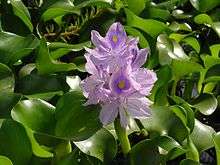 | |
| Scientific classification | |
| Kingdom: | Plantae |
| Clade: | Angiosperms |
| Clade: | Monocots |
| Clade: | Commelinids |
| Order: | Commelinales |
| Family: | Pontederiaceae |
| Genus: | Eichhornia |
| Species: | E. crassipes |
| Binomial name | |
| Eichhornia crassipes | |
Eichhornia crassipes, commonly known as common water hyacinth, is an aquatic plant native to the Amazon basin, and is often a highly problematic invasive species outside its native range.
Description
Water hyacinth is a free-floating perennial aquatic plant (or hydrophyte) native to tropical and sub-tropical South America. With broad, thick, glossy, ovate leaves, water hyacinth may rise above the surface of the water as much as 1 meter in height. The leaves are 10–20 cm across on a stem which is floating by means of buoyant bulb like nodules at its base above the water surface. They have long, spongy and bulbous stalks. The feathery, freely hanging roots are purple-black. An erect stalk supports a single spike of 8–15 conspicuously attractive flowers, mostly lavender to pink in colour with six petals. When not in bloom, water hyacinth may be mistaken for frog's-bit (Limnobium spongia[1]) or Amazon frogbit (Limnobium laevigatum).
One of the fastest growing plants known, water hyacinth reproduces primarily by way of runners or stolons, which eventually form daughter plants. Each plant additionally can produce thousands of seeds each year, and these seeds can remain viable for more than 28 years.[2] Some water hyacinths were found to grow between 2 and 5 metres a day in some sites in Southeast Asia.[3] The common water hyacinth (Eichhornia crassipes) are vigorous growers and mats can double in size in two weeks.[4]
In their native range these flowers are pollinated by long tongued bees and they can reproduce both sexually and clonally. The invasiveness of the hyacinth is related to its ability to clone itself and large patches are likely to all be part of the same genetic form.
Water hyacinth have three flower morphs and are termed "tristylous". The flower morphs are named for the length of their pistil: long, medium and short.[5] However, the short morph is restricted to the native range due to founder events during its distribution.
Habitat and ecology
Its habitat ranges from tropical desert to subtropical or warm temperate desert to rainforest zones. The temperature tolerance of the water hyacinth is the following; its minimum growth temperature is 12 °C (54 °F); its optimum growth temperature is 25–30 °C (77–86 °F); its maximum growth temperature is 33–35 °C (91–95 °F), and its pH tolerance is estimated at 5.0–7.5. Leaves are killed by frost and plants do not tolerate water temperatures > 34 °C (93 °F). Water hyacinths do not grow where the average salinity is greater than 15% that of sea water. In brackish water, its leaves show epinasty and chlorosis, and eventually die. Rafts of harvested water hyacinth have been floated to the sea where it is killed.[6]
Azotobacter chroococcum, a nitrogen-fixing bacteria, is probably concentrated around the bases of the petioles. But the bacteria do not fix nitrogen unless the plant is suffering extreme nitrogen-deficiency.[7]
Fresh plants contain prickly crystals.[6] This plant is reported to contain HCN, alkaloid, and triterpenoid, and may induce itching.[8] Plants sprayed with 2,4-D may accumulate lethal doses of nitrates,[9] and other harmful elements in polluted environments. See further down.
Invasive species
Water hyacinth has been widely introduced in North America, Europe, Asia, Australia, Africa and New Zealand.[10] In many areas it has become an important and pernicious invasive species. In New Zealand it is listed on the National Pest Plant Accord which prevents it from being propagated, distributed or sold. In large water areas such as Louisiana, the Kerala Backwaters in India, Tonlé Sap in Cambodia and Lake Victoria it has become a serious pest. The common water hyacinth has become an invasive plant species on Lake Victoria in Africa after it was introduced into the area in the 1980s.[11]
When not controlled, water hyacinth will cover lakes and ponds entirely; this dramatically affects water flow, blocks sunlight from reaching native aquatic plants which often die. The decay processes depletes dissolved oxygen in the water, often killing fish (or turtles).[12] The plants also create a prime habitat for mosquitos,[13] the classic vectors of disease, and a species of snail known to host a parasitic flatworm which causes schistosomiasis (snail fever).[14] Directly blamed for starving subsistence farmers in Papua New Guinea, water hyacinth remains a major problem where effective control programs are not in place. Water hyacinth is often problematic in man-made ponds if uncontrolled, but can also provide a food source for goldfish, keep water clean[15][16] and help to provide oxygen.[17]
Water hyacinth often invades bodies of water that have already been affected by human activities. For example, the plants can unbalance natural lifecycles in artificial reservoirs or in eutrophied lakes that receive large amounts of nutrients.
Because of E. crassipes invasiveness, several biological control agents have been released to control it, including two weevils (Coleoptera: Curculionidae), Neochetina bruchi Hustache and Neochetina eichhorniae Warner, and the moth Niphograpta albiguttalis (Warren) (Lepidoptera: Pyralidae).[18][19] Neochetina eichhorniae causes "a substantial reduction in water hyacinth production" (in Louisiana); it reduces plant height, weight, root length, and makes the plant produce fewer daughter plants. N. eichhorniae was introduced from Argentina to Florida in 1972.[20] A semi-aquatic grasshopper, Cornops aquaticum, is being investigated in South Africa as an additional control agent.
United States
The water hyacinth was introduced in 1884 at the World's Fair in New Orleans, also known as the World Cotton Centennial.[21] The plants had been given away as a gift by a group of visiting Japanese.[21] Soon after, the water hyacinth was choking rivers, killing fish and stopping shipping in Louisiana, and an estimated 50 kg/m2 choked Florida's waterways.[22] There were many attempts to eradicate the species, including one by the U.S. War Department to pour oil over many of the flowers, but none worked.[21] In 1910, a bold solution was put forth by the New Foods Society. Their plan was to import and release hippopotamus from Africa into the rivers and bayous of Louisiana. The hippopotamus would then eat the water hyacinth and also produce meat to solve another serious problem at the time, the American meat crisis.[23]
Known as the American Hippo bill, H.R. 23621 was introduced by Louisiana Congressman Robert Broussard and debated by the Agricultural Committee of the U.S. House of Representatives. The chief collaborators in the New Foods Society and proponents of Broussard's bill were Major Frederick Russell Burnham, the celebrated American scout, and Captain Fritz Duquesne, a South African scout who later became a notorious spy for Germany. Presenting before the Agricultural Committee, Burnham made the point that none of the animals that Americans ate, chickens, pigs, cows, sheep, lambs, were native to the U.S., all had been imported by European settlers centuries before, so why should Americans hesitate to introduce hippopotamus and other large animals into the American diet? Duquesne, who was born and raised in South Africa, further noted that European settlers on that continent commonly included hippopotamus, ostrich, antelope, and other African wildlife in their diets and suffered no ill effects. The American Hippo bill nearly passed, but fell one vote short.[23]
Africa

The plant was introduced by Belgian colonists to Rwanda to beautify their holdings. It then advanced by natural means to Lake Victoria where it was first sighted in 1988.[24] There, without any natural enemies, it has become an ecological plague, suffocating the lake, diminishing the fish reservoir, and hurting the local economies. It impedes access to Kisumu and other harbors.
The water hyacinth has also appeared in Ethiopia, where it was first reported in 1965 at the Koka Reservoir and in the Awash River, where the Ethiopian Electric Light and Power Authority has managed to bring it under moderate control at considerable cost of human labor. Other infestations in Ethiopia include many bodies of water in the Gambela Region, the Blue Nile from Lake Tana into Sudan, and Lake Ellen near Alem Tena.[25]
The water hyacinth is also present on the Shire River in the Liwonde National Park in Malawi.
The water hyacinth invaded Egypt in Muhammad Ali of Egypt's era.[26]
Asia
Water hyacinth has also invaded the Tonlé Sap lake in Cambodia. An Osmose project in Cambodia is trying to fight it by having local people make baskets from it. It was introduced in Bengal in India because of its beautiful flowers and shapes of leaves, but turned out to be an invasive weed draining oxygen from the water bodies and resulted in death of many fish. Fish is a supplement food in Bengal, and because of the fish scarcity in Bengal caused by Eichhornia, the water hyacinth is also called "Terror of Bengal".
Europe
In August 2016, the European Union banned any sales of the water hyacinth in the EU.[27]
Control
The three commonly used control methods against water hyacinth infestations are physical, chemical, and biological controls. Each has advantages and drawbacks, although biological control is the best solution in the plant's native environment. The optimum control depends on the specific conditions of each affected location such as the extent of water hyacinth infestation, regional climate, and proximity to human and wildlife.[28]
Chemical control
Chemical control is the least used out of the three controls of water hyacinth, because of its long-term effects on the environment and human health. The use of herbicides requires strict approval from governmental protection agencies of skilled technician to handle and spray the affected areas. The use of chemical herbicides is only used in case of severe infiltration of water hyacinth.[29] However, the most successful use of herbicides is when it is used for smaller areas of infestation of water hyacinth. This is because in larger areas, more mats of water hyacinths are likely to survive the herbicides and can fragment to further propagate a large area of water hyacinth mats. In addition, it is more cost-effective and less laborious than mechanical control. Yet, it can lead to environmental effects as it can penetrate into the ground water system and can affect not only the hydrological cycle within an ecosystem but also negatively affect the local water system and human health. It is also notable that the use of herbicides is not strictly selective of water hyacinths; keystone species and vital organisms such as microalgae can perish from the toxins and can disrupt fragile food webs.[28]
The chemical regulation of water hyacinths can be done using common herbicides such as 2,4-D, glyphosate, and diquat. The herbicides are sprayed on the water hyacinth leaves and leads to direct changes to the physiology of the plant.[30] The use of the herbicide known as 2,4-D leads to the death of water hyacinth through inhibition of cell growth of new tissue and cellular apoptosis.[31] It can take almost a two-week period before mats of water hyacinth are destroyed with 2, 4-D. Between 75,000 and 150,000 acres (30,000 and 61,000 ha) of water hyacinth and alligator weed are treated annually in Louisiana.[32]
The herbicide known as diquat is a liquid bromide salt that can rapidly penetrate the leaves of the water hyacinth and lead to immediate inactivity of plant cells and cellular processes. For the herbicide glyphosate, it has a lower toxicity than the other herbicides; therefore, it takes longer for the water hyacinth mats to be destroyed (about three weeks). The symptoms include steady wilting of the plants and a yellow discoloration of the plant leaves that eventually leads to plant decay.[29]
Physical control
Physical control is performed by land-based machines such as bucket cranes, draglines, or boom or by water based machinery such as aquatic weed harvester,[33] dredges, or vegetation shredder.[34] Mechanical removal is seen as the best short-term solution to the proliferation of the plant. A project on Lake Victoria in Africa used various pieces of equipment to chop, collect, and dispose of 1,500 hectares (3,700 acres) of water hyacinth in a 12-month period. It is, however, costly and requires the use of both land and water vehicles, but it took many years for the lake to become in poor condition and reclamation will be a continual process.
It can have an annual cost from $6 million to $20 million and is only considered a short-term solution to a long-term problem. Another disadvantage with mechanical harvesting is that it can lead to further fragmentation of water hyacinths when the plants are broken up by spinning cutters of the plant-harvesting machinery. The fragments of water hyacinth that are left behind in the water can easily reproduce asexually and cause another infestation.[30]
However, transportation and disposal of the harvested water hyacinth is a challenge because the vegetation is heavy in weight. The harvested water hyacinth can pose a health risk to humans because of the plant’s propensity for absorbing contaminants, and it is considered toxic to humans. Furthermore, the practice of mechanical harvesting is not effective in large-scale infestations of the water hyacinth, because this aquatic invasive species grows much more rapidly than it can be eliminated. Only one to two acres (1⁄2 to 1 ha) of water hyacinth can be mechanically harvested daily because of the vast amounts of water hyacinths in the environment. Therefore, the process is very time-intensive.[35]
Biological control
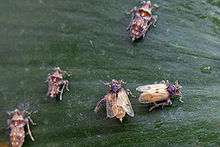
As chemical and mechanical removal is often too expensive, polluting, and ineffective, researchers have turned to biological control agents to deal with water hyacinth. The effort began in the 1970s when USDA researchers released three species of weevil known to feed on water hyacinth into the United States, Neochetina bruchi, N. eichhorniae, and the water hyacinth borer Sameodes albiguttalis. The weevil species was introduced into the Gulf Coast states, such as Louisiana, Texas, and Florida, where there were thousands of acres of infestation from water hyacinth. It was found that a decade later in the 1980s that there was a decrease in water hyacinth mats by as much as 33%. However, because the life cycle of the weevils is ninety days, it puts a limitation on the use of biological predation to efficiently suppress water hyacinth growth.[32] These organisms regulate water hyacinth by limiting water hyacinth size, its vegetative propagation, and seed production. They also carry microorganisms that can be pathological to the water hyacinth. These weevils eat stem tissue, which results in a loss of buoyancy for the plant, which will eventually sink.[30] Although meeting with limited success, the weevils have since been released in more than 20 other countries. However, the most effective control method remains the control of excessive nutrients and prevention of the spread of this species.
In May 2010, the USDA's Agricultural Research Service released Megamelus scutellaris as an additional biological control insect for the invasive water hyacinth species. Megamelus scutellaris is a small planthopper insect native to Argentina. Researchers have been studying the effects of the biological control agent in extensive host-range studies since 2006 and concluded that the insect is highly host-specific and will not pose a threat to any other plant population other than the targeted water hyacinth. Researchers also hope that this biological control will be more resilient than existing biological controls and the herbicides that are already in place to combat the invasive water hyacinth.[36]
Another insect being considered as a biological control agent is the semi-aquatic grasshopper Cornops aquaticum. This insect is specific to the water hyacinth and its family, and besides feeding on the plant, it introduces a secondary pathogenic infestation. This grasshopper has been introduced into South Africa in controlled trials.[37]
Uses
Bioenergy
Because of its extremely high rate of development, Eichhornia crassipes is an excellent source of biomass. One hectare (2.5 acres) of standing crop thus produces more than 70,000 m3/ha (1,000,000 cu ft/acre) of biogas (70% CH
4, 30% CO
2).[38] According to Curtis and Duke, one kg (2.2 lb) of dry matter can yield 370 litres (13 cu ft) of biogas, giving a heating value of 22,000 kJ/m3 (590 Btu/cu ft) compared to pure methane (895 Btu/ft3)[39]
Wolverton and McDonald report approximately 0.2 m3/kg (3 cu ft/lb) methane, indicating biomass requirements of 350 t/ha (160 short ton/acre) to attain the 70,000 m3/ha (1,000,000 cu ft/acre) yield projected by the National Academy of Sciences (Washington).[40] Ueki and Kobayashi mention more than 200 t/ha (90 short ton/acre) per year.[41] Reddy and Tucker found an experimental maximum of more than 1⁄2 tonne per hectare (1⁄4 short ton/acre) per day.[42]
Bengali farmers collect and pile up these plants to dry at the onset of the cold season; they then use the dry water hyacinths as fuel. The ashes are used as fertilizer. In India, one tonne (1.1 short tons) of dried water hyacinth yields about 50 liters ethanol and 200 kg residual fiber (7,700 Btu). Bacterial fermentation of one tonne (1.1 short tons) yields 26,500 ft3 gas (600 Btu) with 51.6% methane (CH
4), 25.4% hydrogen (H
2), 22.1% carbon dioxide (CO
2), and 1.2% oxygen (O
2). Gasification of one tonne (1.1 short tons) dry matter by air and steam at high temperatures (800 °C or 1,500 °F) gives about 40,000 ft3 (1,100 m3) natural gas (143 Btu/ft3) containing 16.6% H
2, 4.8% CH
4, 21.7% CO (carbon monoxide), 4.1% CO
2, and 52.8% N
2 (nitrogen). The high moisture content of water hyacinth, adding so much to handling costs, tends to limit commercial ventures.[40][43] A continuous, hydraulic production system could be designed, which would provide a better utilization of capital investments than in conventional agriculture, which is essentially a batch operation.[6][44]
The labour involved in harvesting water hyacinth can be greatly reduced by locating collection sites and processors on impoundments that take advantage of prevailing winds. Wastewater treatment systems could also favourably be added to this operation. The harvested biomass would then be converted to ethanol, biogas, hydrogen, gaseous nitrogen, and/or fertilizer. The byproduct water can be used to irrigate nearby cropland.[6]
Phytoremediation, waste water treatment
The roots of Eichhornia crassipes naturally absorb pollutants, including lead, mercury, and strontium-90, as well as some organic compounds believed to be carcinogenic, in concentrations 10,000 times that in the surrounding water.[45] Water hyacinths can be cultivated for waste water treatment (especially dairy waste water).[6]
Water hyacinth is reported for its efficiency to remove about 60–80% nitrogen[46] and about 69% of potassium from water.[47] The roots of water hyacinth were found to remove particulate matter and nitrogen in a natural shallow eutrophicated wetland.[48][49]
Edibility
The plant is used as a carotene-rich table vegetable in Taiwan. Javanese sometimes cook and eat the green parts and inflorescence.[6]
Medicinal use
In Kedah (Malaysia), the flowers are used for medicating the skin of horses.[6] The species is a "tonic".[50][51]
Potential as bioherbicidal agent
Water hyacinth leaf extract has been shown to exhibit phytotoxicity against another invasive weed Mimosa pigra. The extract inhibited the germination of Mimosa pigra seeds in addition to suppressing the root growth of the seedlings. Biochemical data suggested that the inhibitiory effects may be mediated by enhanced hydrogen peroxide production, inhibition of soluble peroxidase activity, and stimulation of cell wall-bound peroxidase activity in the root tissues of Mimosa pigra.[52]
Other uses
In East Africa, water hyacinths from Lake Victoria are used to make furniture, handbags and rope.[53] The plant is also used as animal feed and organic fertilizer although there is controversy stemming from the high alkaline pH value of the fertilizer.[54] Though a study found water hyacinths of very limited use for paper production,[55] they are nonetheless being used for paper production on a small scale.
American-Nigerian Achenyo Idachaba has won an award for showing how this plant can be exploited for profit in Nigeria.[56]
In places where water hyacinth is invasive, overabundant, and in need of clearing away, these traits make it free for the harvesting, which makes it very useful as a source of organic matter for composting in organic farming in those locales, provided that the composting method properly handles it. As an aquatic plant, it requires most of the same composting principles as the seaweed that is composted close to sea coasts.
In Bangladesh, farmers in the southwestern region cultivate vegetables on the dried mass of water hyacinth. As a large portion of cultivable land goes under water for months during monsoon in this low-lying region, farmers have grown this method for many decades now. The method of this agriculture is known as 'Dhape chash'.
Gallery
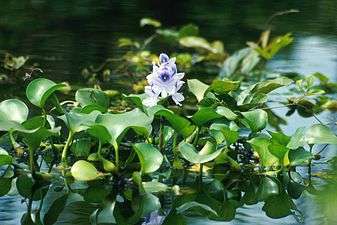 Floating plant
Floating plant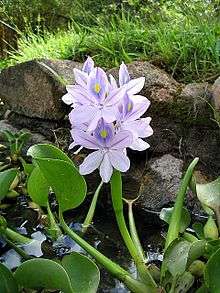 Flowers
Flowers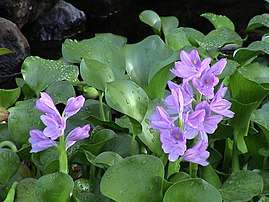 Close-up of flowers
Close-up of flowers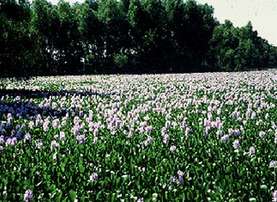 Large pond covered with water hyacinth
Large pond covered with water hyacinth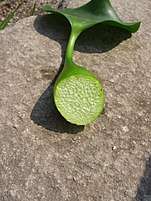 Inflated petiole
Inflated petiole Huge swamp field populated by Eichhornia crassipes
Huge swamp field populated by Eichhornia crassipes
References
- ↑ "Limnobium spongia". UF / IFAS Center for Aquatic and Invasive Plants.
- ↑ Sullivan, Paul R; Wood, Rod (2012). Water hyacinth (Eichhornia crassipes (Mart.) Solms) seed longevity and the implications for management (PDF). 18th Australasian Weeds Conference. Melbourne.
- ↑ Gopal, Brij (1987). Water Hyacinth (Aquatic Plant Studies). Elsevier Science. ISBN 978-0444427069.
- ↑ Batcher, Michael S. "Eichhornia crassipes". BugwoodWiki. Missing or empty
|url=(help);|access-date=requires|url=(help) - ↑ "Eichhornia crassipes (water hyacinth)". Invasive Species Compendium. CABI. Retrieved 14 November 2017.
- 1 2 3 4 5 6 7 Duke, J. (1983). "Eichhornia crassipes (Mart.) Solms". Handbook of Energy Crops.
- ↑ Water hyacinth: a plant with prolific bioproductivity and photosynthesis. By S. Matai and D.K. Bagchi. 1980. pp. 144–148 in: Gnanam, A., Krishnaswamy, S., and Kahn, J.S. (eds.), Proc. Internat. Symp. on Biol. Applications of Solar Energy. MacMillan Co. of India, Madras. Cited in Duke (1983).
- ↑ Medicinal plants of east and southeast Asia. By L.M Perry. 1980. MIT Press, Cambridge. Cited in Duke (1983).
- ↑ Tropical feeds. Feed information summaries and nutritive values. By B. Gohl. 1981. FAO Animal Production and Health Series 12. FAO, Rome. Cited in Duke (1983).
- ↑ Gannon, Mike (15 January 2014). "Water Hyacinth – In and Out of Your Water Garden". Full Service Aquatics.
- ↑ Chepkoech, Anita (7 February 2017). "Removal of Water Hyacinth Could Take Longer, Expert Says". Daily Nation.
- ↑ Voiland, Adam (1 June 2016). "Seven Things You Didn't Know About Water Hyacinth". Earth Observatory. Retrieved 21 November 2017.
- ↑ "Non-native Invasive Freshwater Plants — Water Hyacinth (Eichornia crassipes) — Technical Information". Washington State Department of Ecology. Archived from the original on 2017-11-15. Retrieved 21 November 2017.
- ↑ Coles, G.C.; Kabatereine, N.B. (June 2008). "Water hyacinth and the transmission of schistosomiasis". Transactions of the Royal Society of Tropical Medicine and Hygiene. 102 (6): 619–620. doi:10.1016/j.trstmh.2008.01.009. PMID 18374376.
- ↑ Todd, J.; Josephson, B. (May 1996). "The design of living technologies for waste treatment" (PDF). Ecological Engineering. 6 (1–3): 109–136. doi:10.1016/0925-8574(95)00054-2.
- ↑ Sheffield, С.W. (June 1967). "Water Hyacinth For Nutrient Removal" (PDF). Journal of Aquatic Plant Management (JAPM). 6: 27–30. Retrieved 31 July 2013.
- ↑ Hanson, Sarah (20 March 2013). "Eichhornia crassipes – The 'Jekyll and Hyde' of the freshwater world". Tropical Biodiversity. Retrieved 21 November 2017.
- ↑ Julien, M.H., and Griffiths, M.W. (1998), Biological Control of Weeds: A World Catalogue of Agents and their Target Weeds (4th ed.), Oxon, UK: CABI Publishing, CAB International.
- ↑ "Biological Control of Weeds — A World Catalogue of Agents and their Target Weeds". iBiocontrol. The University of Georgia – Center for Invasive Species and Ecosystem Health. Retrieved 14 November 2017.
- ↑ Suppressing water hyacinth with an imported weevil. By R.A. Goyer and J.D. Stark. 1981. La. Agr. 24(4):4–5. Cited in Duke (1983).
- 1 2 3 Miller, Greg (20 December 2013). "The Crazy, Ingenious Plan to Bring Hippopotamus Ranching to America". Wired. ISSN 1059-1028.
- ↑ "A Troublesome "Water Weed"". Popular Science Monthly. LII: 429. January 1898. Retrieved 14 November 2017.
- 1 2 Mooallem, John (2013). "American Hippopotamus". The Atavist. Vol. 32. New York. Retrieved 14 November 2017.
- ↑ Thielke, Thilo (2 September 2008). "Die grüne Pest" [The Green Pest]. Spiegel Online (in German). Retrieved 2 September 2008.
- ↑ Rezene, F. (2005). "Water Hyacinth (Eichhornia crassipes): A Review of its Weed Status in Ethiopia". Arem. 6: 105–111. Cited in Yirefu, F.; Tafesse, A.; Gebeyehu, T.; Tessema, T. (2007). "Distribution, Impact and Management of Water Hyacinth at Wonji-Shewa Sugar Factory" (PDF). Eth. J. Of Weed Mgt. 1 (1): 41–52. Archived from the original (PDF) on 2014-02-22.
- ↑ Hussein, Walaa (7 September 2016). "How this invasive flower is taking over the Nile". Al-Monitor. CAIRO.
- ↑ "EU bans our top pond plant – to protect Spain: Water hyacinth added to banned list meaning it cannot be grown or sold anywhere within Union". DailyMail.com.
- 1 2 Villamagna, Amy; Murphy, Brian (27 August 2009). "Ecological and socio-economic impacts of invasive water hyacinth (Eichhornia crassipes): a review". Freshwater Biology. 55 (2): 282–298. doi:10.1111/j.1365-2427.2009.02294.x.
- 1 2 "Water Hyancith". California State Parks: Division of Boating and Waterways. State of California: Division of Boating and Waterways. Archived from the original on 2014-11-14.
- 1 2 3 Jiménez, Maricela. "Progress on water hyacinth (Eichhornia crassipes) management". Food and Agriculture Organization of the United Nations. Retrieved 4 November 2014.
- ↑ Jiménez, VM (November 2005). "Involvement of plant hormones and plant growth regulators on in vitro somatic embryogenesis". Plant Growth Regulation. 47 (2–3): 91–110. doi:10.1007/s10725-005-3478-x.
- 1 2 Sanders, Dearl; Jonhson, Seth; Kelso, Bill (Fall 2010). "Invasive Aquatic Weeds in Louisiana". Louisiana Agriculture. 53 (4): 34–37. Retrieved 13 October 2014.
- ↑ "Aquatic Weed Harvester". Aquarius Systems.
- ↑ "Vegetation Shredders". Aquarius Systems.
- ↑ Malik, Anushree (January 2007). "Environmental challenge vis a vis opportunity: The case of water hyacinth". Environment International. 33 (1): 122–138. doi:10.1016/j.envint.2006.08.004. PMID 17010439.
- 1 2 "Scientists Release Biocontrol for Waterhyacinth". United States Department of Agriculture, Agricultural Research Service.
- ↑ Balian, E.V.; Lévêque, C.; Segers, H.; Martens, K., eds. (2008). Freshwater Animal Diversity Assessment (Reprinted from Hydrobiologia, Volume 595 (2008)). Springer Science & Business Media. p. 542. ISBN 978-1-4020-8259-7.
- ↑ National Research Council (1976). Making Aquatic Weeds Useful: Some Perspectives for Developing Countries. Washington, DC: The National Academies Press. doi:10.17226/19948. ISBN 978-0-309-33457-0. Retrieved 15 November 2017.
- ↑ An assessment of land biomass and energy potential for the Republic of Panama. By C.R. Curtis and J.A. Duke. 1982. vol. 3. Institute of Energy Conversion. Univ. Delaware. Cited in Duke (1983).
- 1 2 Energy from vascular plant wastewater treatment systems – Eichhornia crassipes, Spirodela lemna, Hydrocotyle ranunculoides, Pueraria lobata, biomass harvested for fuel production. By B.C. Wolverton and R.C. McDonald. 1981. Econ. Bot. 35(2):224–232. Cited in Duke (1983).
- ↑ Cultivation of new biomass resources. By K. Ueki and T. Kobayashi. 1981. Energy Develop. in Japan. 3(3):285–300. Cited in Duke (1983).
- ↑ Productivity and nutrient uptake of water hyacinth Eichhornia crassipes. By K.R. Reddy and J.C. Tucker. 1983. 1. Effect of nitrogenous source. Econ. Bot. 37(2):237–247. Cited in Duke (1983).
- ↑ The wealth of India. By C.S.I.R. (Council of Scientific and Industrial Research). 1948–1976. 11 vols. New Delhi. Cited in Duke (1983).
- ↑ Energy from fresh and brackish water aquatic plants. By J.R. Benemann. 1981. pp. 99–121. In: Klass, D.L. (ed.), Biomass as a non-fossil fuel source. ACS Symposium Series 144. ACS. Washington. Cited in Duke (1983).
- ↑ "UNKNOWN". Biology Briefs. BioScience. 26 (3): 224. March 1976. doi:10.2307/1297259. JSTOR 1297259.
- ↑ Fox, LJ; Struik, PC; Appleton, BL; Rule, JH; et al. (2008) Nitrogen phytoremediation by water hyacinth (Eichhornia crassipes (Mart.) Solms). Water Air Soil Pollut 194:199–207
- ↑ Zhou, W; Zhu, D; Tan, L; Liao, S; Hu, H; David, H; et al. (2007) Extraction and retrieval of potassium from water hyacinth (Eichhornia crassipes). Biores Tech 98:226–231
- ↑ Billore, SK; Bharadio, R; Kumar, A; et al. (1998) Potential removal of particulate matter and nitrogen through roots of water hyacinth in a tropical natural wetland. Curr Sci 74:154–156
- ↑ Ansari, Abid; Gill, Sarvajeet; Khan, Fareed; Ghauri, Naeem (2014). Phytoremediation Systems for the Recovery of Nutrients from Eutrophic Waters. Eutrophication: Causes, Consequences and Control. 2. pp. 239–248. doi:10.1007/978-94-007-7814-6_17. ISBN 978-94-007-7813-9.
- ↑ Medicinal plants of the world. By J.A. Duke and K.K Wain. 1981. Computer index with more than 85,000 entries. 3 vols.
- ↑ Oudhia, P. (Winter 2001). "Traditional medicinal knowledge about a noxious weed, jal kumbhi (Eichhornia crassipes), in Chhattisgarh (India)" (PDF). AQUAPHYTE Online. 21 (2). ISSN 0893-7702.
- ↑ Chai, TT; Ngoi, JC; Wong, FC (2013). "Herbicidal potential of Eichhornia crassipes leaf extract against Mimosa pigra and Vigna radiata" (PDF). International Journal of Agriculture and Biology. 15 (5): 835‒842.
- ↑ Aguilo, Patricia; L’Esperance, Amanda; Mbau, Elizabeth; Palmer, Phillip; Patel, Asmita; Sparkman, Tim (10 May 2007). "Attracting Investment to Kisumu: Opportunities and Challenges" (PDF). Columbia University. p. 78. Archived from the original (PDF) on 2012-09-16.
- ↑ "Eichhornia crassipes". Global Invasive Species Database.
- ↑ Nolad, W.J.; Kirmse, D.W. (May 1974). "The Papermaking Properties of Waterhyacinth" (PDF). Journal of Aquatic Plant Management (JAPM). 12: 90–97.
- ↑ How I turned a deadly plant into a thriving business, Achenyo Idachaba, TED, May 2015
- Duke, J. (1983). Handbook of Energy Crops. Purdue University. (Complete List of References) Available only online. An excellent source of information on numerous plants. Welcome to NewCROP
External links
| Wikimedia Commons has media related to Eichhornia crassipes. |
| Wikispecies has information related to Eichhornia crassipes |
- Eichhornia crassipes in West African plants – A Photo Guide.
- Species Profile – Water Hyacinth (Eichhornia crassipes), National Invasive Species Information Center, United States National Agricultural Library. Lists general information and resources for Water Hyacinth.
- Eichhornia crassipes Israel Wildflowers and native plants
- Practical uses of Water Hyacinth
- IUCN Leaflet on E. crassipes in the context of Lake Tanganyika